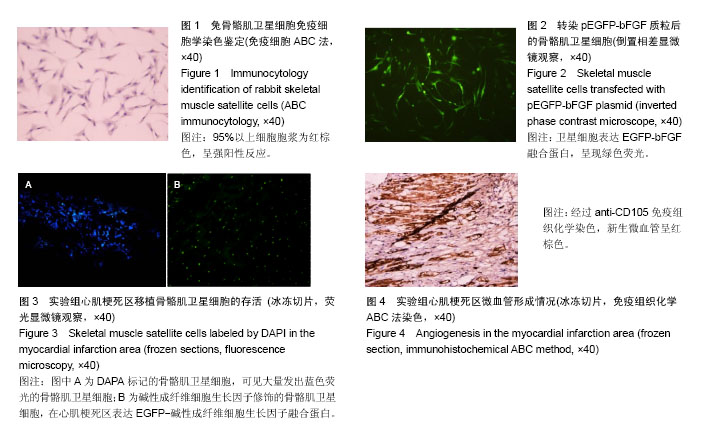| [1] Mesires NT,Doumit ME.Satellite cell proliferation and differentiation during postnatal growth of porcine skeletal muscle.Am J Physiol Cell Physiol. 2002;282(4):C899-906.[2] Fujimaki S,Machida M,Hidaka R,et al.Intrinsic ability of adult stem cell in skeletal muscle: an effective and replenishable resource to the establishment of pluripotent stem cells.Stem Cells Int.2013;2013:420-424.[3] Kao GW,Lamb EK,Kao RL,et al.Skeletal muscle stem cells. Methods Mol Biol. 2013;1036:19-32.[4] 王立新,高长青.自体骨骼肌星状细胞心肌成形的实验研究[J].中华医学杂志,2002,82(2):100-103.[5] Ye L,Haider HK,Tan R,et al.Angiomyogenesis using liposome based vascular endothelial growth factor-165 transfection with skeletal myoblast for cardiac repair. Biomaterials.2008; 29(13):2125-2137.[6] Usas A,Huard J.Muscle-derived stem cells for tissue engineering and regenerative therapy. Biomaterials. 2007; 28(36):5401-5406.[7] 徐青,徐敏,张加吉,等.壁虎骨骼肌卫星细胞的原代培养与鉴定[J].交通医学,2011,25(2):110-112.[8] 许志锋,李敬来,韩振,等.阳离子脂质体介导增强型绿色荧光蛋白质粒转染骨骼肌卫星细胞[J].中国组织工程研究,2013,17(46): 86-91.[9] Swedlow JR,Goldberg l,Brauner E,et al.Informatics and quantitative analysis in biological imaging.Science.2003; 300(5616):100-102.[10] 李国营,田素民,于连发,等.兔心肌缺血及缺血再灌注模型的制备[J].解剖学研究,2004,24(3):237-238.[11] 蒋清安,何国祥,刘建平,等.一种新的非人工通气兔心肌梗死模型的制作[J].第三军医大学学报,2008,30(5):406-409.[12] 何智明,陈东风,邹香云,等.家兔心肌缺血模型与冠状动脉左室支解剖特点关系[J].中国临床解剖学杂志,1994,12(1):54-56.[13] Minhajat R,Mori D,Yamasaki F,et al.Organ-specific endoglin(CD105) expression in the angiogenesis of human cancers.Pathol Int.2006;56(12):717-723.[14] Weidner N.Current pathologic methods of measuring intratumoralmicrovessel density within breast carcinoma and other solidertumors.Breast Cancer Res Treat. 1995;36(1): 169-180.[15] 倪玉霞,刘小青,李贻奎,等.骨髓间充质干细胞移植联合冠心Ⅱ号对大鼠急性心肌梗死心功能和血管新生的影响[J].中国组织工程研究与临床康复,2008,12(47):9201-9209.[16] Muñoz-Cánoves P,Carvajal JJ,Lopez de Munain A et al.Role of Stem Cells in Skeletal Muscle Development, Regeneration, Repair, Aging, and Disease. Front Aging Neurosci.2016;8:95.[17] Arnold HH,Winter B.Muscle differentiation: more complexity to the network of myogenic regulators.Curr Opin Genet Dev. 1998; 8:539-544.[18] Peault B,Rudnicki M,Torrente Y,et al.Stem and progenitor cells in skeletal muscle development, maintenance, and therapy.Mol Ther.2007;15:867-877.[19] Mesires NT,Doumit ME.Satellite cell proliferation and differentiation during postnatal growth of porcine skeletal muscle.Am J Physiol Cell Physiol.2002;282:C899-906.[20] Seidel M,Borczyńska A,Rozwadowska N,et al.Cell-based therapy for heart failure: skeletal myoblasts.Cell Transplant. 2009;18(7):695-707.[21] Nakamura Y,Asakura Y,Piras B,et al.AIncreased angiogenesis and improved left ventricular function after transplantation of myoblasts lacking the MyoD gene into infarcted myocardium.PLoS One.2012;7(7):417-436.[22] Shudo Y, Miyagawa S, Ohkura H et al. Addition of mesenchymal stem cells enhances the therapeutic effects of skeletal myoblast cell-sheet transplantation in a rat ischemic cardiomyopathy model.Tissue Eng Part A.2014;20(3-4): 728-739.[23] Sanganalmath SK,Bolli R.Cell therapy for heart failure: a comprehensive overview of experimental and clinical studies, current challenges, and future directions.Circ Res.2013; 113(6):810-834.[24] House SL,Castro AM,Lupu TS,et al.Endothelial fibroblast growth factor receptor signaling is required for vascular remodeling following cardiac ischemia-reperfusion injury.Am J Physiol Heart Circ Physiol.2016;310(5):H559-571.[25] Zhao T,Zhao W,Chen Y,et al.Acidic and basic fibroblast growth factors involved in cardiac angiogenesis following infarction.Int J Cardiol.2011;152(3):307-313. |
.jpg)

.jpg)